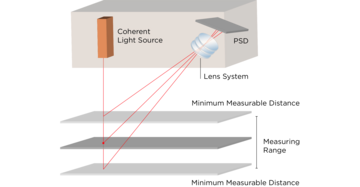Optoelectronic Personal Protection via Distance Measurements
Distance Measurements using Triangulation
Triangulation is used in automatic revolving doors: If a person stops moving in the door wing, the automatic rotation mechanism has to be stopped automatically to prevent the door from colliding with the person.
The optoelectronic sensor consists of a laser diode and a receiver that can determine the position; position-sensitive detectors (PSDs) or CCD cameras are used for this purpose.
Object Recognition
Beyond Borders


Put simply, object recognition is carried out as follows: In the drawing, you will see sensors that are set up one after the other on the rear door wing to continuously measure the distance to the floor.
As soon as the measured distance is reduced, a barrier is recognized and the door system stopped.
Laser Scanners
Beyond Borders

If high precision and speed are required, then it is necessary to utilize laser scanners instead of triangulation. In revolving doors, laser scanners are used to protect against trapping; in industrial automation, they are used to protect people from machines. The sensors recognize intrusion into a danger zone and trigger a (machine) stop.
Object Recognition with Laser Scanners
Beyond Borders
Laser scanners are based on optical time-of-flight measurements. The typical assembly of industrial laser scanners requires a rotating mirror for the setup of a two-dimensional surface in order to capture the surroundings (see figure). This type of system achieves a high angular resolution that makes it possible to perform an exact distance measurement and provides a high degree of detail of the scan.
Typically, industrial laser scanners capture an angular range of up to 270°; in automotive applications, 360° are captured. In a three-sided mirror, the scanning area is scanned three times per rotation. If the mirror surfaces were tipped, it would even be possible to scan surfaces that are inclined toward each other rather than a purely two-dimensional surface.
Quality Features of Pulsed Laser Diodes
Beyond Borders
Laser scanners are used to monitor very different distance ranges. As shown in the calculation, if an object is measured at a distance of 75 m and a time delay of 500 ms, the pulse for objects at a distance of 2 m is detected after just 13 ns.
Therefore, pulsed laser diodes are required that have the lowest pulse width possible for distance measurements at short distances. The shorter the laser pulse, the higher the precision. Typical versions have a width of less than 10 ns – novel technologies are already in the starting blocks.
However, at far distances, it is necessary to ensure that the pulse power is high enough to detect a returning signal. For both requirements, the trick is to select the right components and switch the laser source and receiver properly.
Our Experts
Beyond Borders

Product Selection
Beyond Borders







